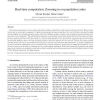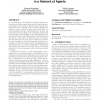42 search results - page 7 / 9 » Slicing and dicing the information space using local context... |
IRES
2002
13 years 5 months ago
2002
Building the semantic web encounters problems similar to building large bibliographic systems. The experience of librarianship in controlling large, heterogeneous collections of b...
ICIP
2003
IEEE
14 years 7 months ago
2003
IEEE
We present a probabilistic method for audio-visual (AV) speaker tracking, using an uncalibrated wide-angle camera and a microphone array. The algorithm fuses 2-D object shape and ...
CHI
2006
ACM
14 years 5 months ago
2006
ACM
`Embedded phenomena' is a learning technology framework in which simulated scientific phenomena are mapped onto the physical space of classrooms. Students monitor and control...
BIOSYSTEMS
2007
13 years 5 months ago
2007
Information processing in nervous systems intricately combines computation at the neuronal and network levels. Many computations may be envisioned as sequences of signal processin...
ATAL
2007
Springer
13 years 11 months ago
2007
Springer
To cope with large scale, agents are usually organized in a network such that an agent interacts only with its immediate neighbors in the network. Reinforcement learning technique...


